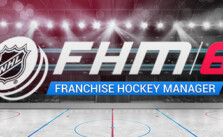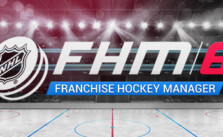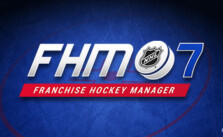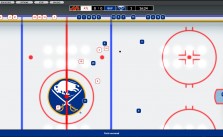Franchise Hockey Manager 6 – Player Attributes Guide

A player’s ratings control the individual detailed aspects of his performance. Attributes are the basic building block of a player’s ratings. They are split into two categories, hidden and visible. Visible attributes can be seen during the game (unless using blind mode/fog of war), while hidden attributes are invisible unless you use commissioner mode to edit player ratings. Otherwise, you must rely on scouting reports to get an idea of what kind of hidden ratings a player has.
The visible categories are further split into four groups, offensive, defensive, mental, and physical (physical meaning actually related to physical performance, like skating, not just the traditional usage of “physical” as a hockey term implying aggressive play.) All attributes have a normal range of 1-20, with 20+ allowed in extraordinary cases. Below is a detailed explanation of what each individual attribute represents, taken in part from the editing guide used by the database researchers.
Acceleration (Physical)
How quickly the player reaches his maximum speed. There’s no way to quantify any skating attribute with game stats, although skills competition results may give you some good indications of acceleration, speed, and agility – just bear in mind those aren’t happening in game conditions, so don’t feel obliged to give the player who recorded the fastest lap time in a skills competition the highest acceleration and speed numbers if other players are clearly faster during games. Penalty-killing forwards tend to be faster than average, so checking stats like PK time and shorthanded goals/assists may give you some indications that the player deserves a high speed rating – particularly if he’s getting used in that role despite not being good defensively. And, obviously, high-scoring players tend to be better skaters than lower scorers (although there are certainly slow but high-scoring players, and fast players who don’t get a lot of points.)
Aggression (Mental)
The player’s tendency towards physical aggressiveness. This is mainly based on the number of penalty minutes he gets per minute played (as opposed to raw PIM numbers, which would exaggerate the aggressiveness of players who get a lot of playing time. Values >20 will be more common here than for other attributes.
Agility (Physical)
The player’s ability to move quickly to evade opposing players, or respond to an opponent’s evasions. A player doesn’t necessarily have to be fast to be agile. Size will tend to be inversely related to agility, bigger players will in most (but not all) cases be less agile and smaller ones more agile.
Aging (Hidden)
Aging determines, very approximately, the age at which a player’s abilities (at least, the ones that are affected negatively by age) are likely to begin to decline. The exact formula for when that happens involves a combination of the Player Peak Age setting you may have seen in the game options, the Aging attribute, and some random elements.
Ambition (Hidden)
The player’s tendency to value winning over other forms of reward. High-ambition players will prefer to play for successful teams. Obvious evidence of a high-ambition player would be things like multiple free agent moves to contending teams; players who sign with non-contenders are likely candidates for lower Ambition ratings.
Balance (Physical)
The player’s ability to remain upright in a controlled manner when in contact with an opposing player (regardless of which one of them initiated the contact.) Note that last part – it shouldn’t take into account non-contact situations.
Big Games (Hidden)
The player’s tendency to play better or worse than his normal level during important games (playoffs, international games, promotion/relegation, etc.) Evidence for this should be fairly obvious – does the player score significantly more or less than his average regular-season rate in such games, and/or does his coach use him more often in those games?
Don’t raise or lower this attribute by more than a couple of points based on the performance in any single year – the highest-rated players should have a clear pattern of good performance in big games over the course of several seasons.
Bravery (Mental)
The player’s willingness to put himself into physically risky positions – in front of the net, in the corners, fighting for the puck with bigger and stronger players. Note that shot blocking should not be considered here, since there’s a completely separate attribute for it. It’d be a little ridiculous to have the same attribute control both the willingness of a forward to take punishment in the slot and his ability to block shots, wouldn’t it?
Checking (Defensive)
The player’s ability to lower the chances of an offensive player to succeed at what he is attempting to do, whether the player has the puck or not. This is a very broadly-defined attribute, and is one of the more important ones for determining defensive effectiveness.
Coachability (Hidden)
How easy it is for coaches to get this player to improve. A high/low number here will have a significant effect on the player’s likelihood of improving his skills.
Controversy (Hidden)
The higher the number, the more likely the player is to be involved in controversial situations, i.e. “create drama.” Note that this refers to things that are likely to make his teammates/management upset with him, not stuff that he does to irritate opponents – a player might be hated around the league for what he does on the ice, but if he’s not known for having issues with teammates, he shouldn’t have an unusually high number here.
Defensive Read (Defensive)
The player’s ability to understand what the offense is about to try to do, and what that implies for his team’s current defensive arrangement.
The essential difference between Positioning and Defensive Read is that Defensive Read is used to assess the current situation, and Positioning is used to respond to it. It’s possible for a defender to make the wrong decision on the play in three ways – reading the play correctly but then positioning himself incorrectly; reading the play incorrectly and then positioning himself correctly for the siuation he perceived, but which doesn’t actually exist; or getting both wrong by making a bad read and then responding in a way that isn’t even correct for his faulty assumption. Most competent defensive defencemen should have a reasonably good positioning attribute: they’ll reliably make a correct decision about what to do based on what they see in front of them. But some (Nicklas Lidstrom, Rod Langway, Dan Girardi) will carry this a step further by consistently understanding what’s coming at them. Note that it’s possible to create some variety in a player’s defensive flaws using these two attributes: a smart player might understand perfectly well what’s going on, but be lazy or sloppy in his responses to it, or simply panic. Or a guy might understand his defensive responsibilities perfectly, but lack the hockey sense to understand what’s happening around him.
Determination (Mental)
The player’s tendency to be unaffected by bad news both during and after games, e.g. losses, going down by multiple goals, demotions to lower leagues, being benched. High-determination players will be less likely to be affected by those events.
Faceoffs (Defensive)
The player’s ability to win faceoffs. This is fairly straightforward, particularly if his league keeps track of faceoff statistics.
Fighting (Physical)
The fighting rating primarily affects the frequency with which a player fights, and, to a much lesser extent, his fighting skill. It can be very difficult to get in-game fighting stats that match real life because the use of fighters on the roster is heavily dependent on AI decision-making and fringe players like goons are prone to being shuffled around.
Getting Open (Offensive)
The player’s ability to find a place to shoot from when his team has the puck but he’s not carrying it. This is very important to the player’s shot totals and also has an effect on their quality.
Greed (Hidden)
The player’s tendency to value money over other forms of reward. During contract negotiations, high-Greed players will attach more importance to the financial aspect of the offer than they will to factors like playing for a winning team or moving to a higher-level league.
Handle Failure (Hidden)
The higher the number, the less likely the player is to behave poorly in response to his and/or the team’s failures.
Handle Success (Hidden)
The higher the number, the less likely the player is to behave poorly in response to his and/or the team’s success.
Handle Critics (Hidden)
The higher the number, the less likely the player is to respond poorly to criticism (from management or the media.)
Hitting (Defensive)
The player’s ability to separate the puck carrier from the puck with a bodycheck (legal or otherwise.) This will obviously have a large influence on the “hits” stat, but researchers should be wary of the inconsistencies in counting real-life hit stats that make those an unreliable source to base hit ratings on. At most, consider them a very general guide.
Injury Proneness (Hidden)
The player’s tendency to get hurt. A higher number means more injuries, so give those to players who have significant injury histories or play in a way that’s likely to get them hurt more frequently.
Intelligence (Hidden)
A rough indication of the player’s intellectual abilities, but with some of what you’d call “emotional IQ” or “wisdom” mixed in. Note that this isn’t necessarily a positive trait for team chemistry: intelligent guys may be more outspoken, while dumber ones may be a little more compliant.
Leadership (Mental)
The player’s ability to positively influence the in-game performance and off-ice happiness of his teammates. The most obvious evidence of this is whether the player is a Captain or an Alternate Captain; those guys should usually have the highest leadership ratings on the team.
Loyalty (Hidden)
The player’s tendency to stay with one team. The higher the attribute, the less likely he’ll be to leave. In combination with Greed, this can have a significant effect on his salary demands during contract negotiations. Signs of high or low Loyalty should be fairly obvious – multiple years with one team vs. frequently changing teams and/or leagues.
Mood (Hidden)
The player’s starting level of happiness towards the team’s locker room situation.
Offensive Read (Offensive)
The player’s ability, while his team has the puck, to determine how to respond to the current on-ice situation (i.e., the positioning of both the offensive and defensive teams) with the intention of scoring.
Pass/Shoot Tendency (Hidden)
The player’s tendency to try to improve a scoring chance by passing to a teammate, rather than shooting himself. This will have a very strong influence on his shot totals and his goal:assist ratio. So, not surprisingly, real-life goal:assist ratios and shot totals should be very good indicators of how to set this attribute. The more he shoots/scores, the lower his Pass/Shoot attribute.
Passing (Offensive)
The player’s ability to make an accurate, tape-to-tape pass to a player in a good position to safely receive it.
Positioning (Defensive)
The player’s ability to move, when defending, to the proper spot on the ice in the current situation.
The essential difference between Positioning and Defensive Read is that Defensive Read is used to assess the current situation, and Positioning is used to respond to it. It’s possible for a defender to make the wrong decision on the play in three ways – reading the play correctly but then positioning himself incorrectly; reading the play incorrectly and then positioning himself correctly for the siuation he perceived, but which doesn’t actually exist; or getting both wrong by making a bad read and then responding in a way that isn’t even correct for his faulty assumption. Most competent defensive defencemen should have a reasonably good positioning attribute: they’ll reliably make a correct decision about what to do based on what they see in front of them. But some (Nicklas Lidstrom, Rod Langway, Dan Girardi) will carry this a step further by consistently understanding what’s coming at them. Note that it’s possible to create some variety in a player’s defensive flaws using these two attributes: a smart player might understand perfectly well what’s going on, but be lazy or sloppy in his responses to it, or simply panic. Or a guy might understand his defensive responsibilities perfectly, but lack the hockey sense to understand what’s happening around him.
Professionalism (Mental)
The player’s tendency to play to the best of his abilities in bad or unpleasant circumstances. Professionalism works mainly to mitigate effects that might lower the player’s morale, or be caused by low morale. It’ll be considered by the AI when deciding which of its players get the “Leader” secondary role.
Puckhandling (Offensive)
The player’s ability, while carrying the puck, to avoid turning it over due to an opponent’s checking or his own maneuvering.
Screening (Offensive)
The player’s ability to reduce the goalie’s chance at making a save by interfering with his ability to see/react to a shot. Note that this isn’t intended to reflect the player’s ability to tip in shots himself or score from directly in front of the net, but rather how well he helps his teammates score. It’s more of a “Tomas Holmstrom” attribute than a “Tim Kerr” one, although a big guy that typically scores a lot from the slot will probably still be above-average at screening. Forwards will typically have a much higher rating than defencemen (balanced by the difference in shooting ranges.)
Shooting Accuracy (Offensive)
Shooting Accuracy is the player’s effectiveness at hitting a target (i.e., an empty part of the net) with his shot. This attribute must be considered in combination with Shooting Range – the Range is the maximum distance at which the player has the level of precision specified by his Accuracy. Defencemen typically will have much lower accuracy ratings than forwards, which will tend to balance the reversed situation in shooting range. Shooting percentage is a very good indicator for this stat.
Shooting Range (Offensive)
Shooting range works differently than most other attributes. It identifies, roughly in metres from the goaltender (assuming the goalie is in the crease), the maximum range from which the player shoots at 100% of his normal accuracy; shooting from farther out than that lowers the chance of the shot going in. Defencemen will almost always have longer shooting ranges than forwards, since most of their shots will be from the point (this is balanced by lower accuracy ratings for them.)
(There is code in the game to adjust the range attribute for forwards or defencemen when they are moved to the other type of position in the lineup, you don’t need to consider that.)
Shot Blocking (Defensive)
The willingness and skill level of the player when trying to block shots. Defencemen should normally tend to get higher ratings than forwards, which balances out the extra defensive points the forwards get from the Faceoff attribute. If the player’s league records shot-blocking stats, these would be very useful in setting this attribute.
Speed (Physical)
How fast the player moves at his maximum speed, regardless of how long it takes him to reach that speed.
Sportsmanship (Hidden)
The player’s tendency to play by the rules; the opposite of dirtiness. Primarily used in determining some types of penalties, like retaliation and misconducts.
Stamina (Physical)
How long the player can stay on the ice, both on a per-shift and per-game basis: i.e., basically his level of aerobic fitness. The amount of icetime players get is one indication of this, but remember that icetime is primarily determined by how talented the player is – so don’t just set it in order of who plays the most. You’ll have to go more on subjective opinion, although you may occassionally run into a stat that gives you good evidence of stamina (e.g., Kevin Bieksa’s stats have been known to be significantly worse in games where he plays more than 20 minutes.) And training data is useful here – if somebody’s noted for consistently finishing first when the team goes running, he should get a higher stamina rating.
Stickchecking (Defensive)
The player’s ability to cause the puck carrier to lose possession by using his stick (not specifically via poke-checking, although that’s a significant factor to consider.) Basically the technical counterpart to the Hitting attribute.
Strength (Physical)
The physical strength of the player as applied to hockey situations. Used as a factor in determining things like puck possession/turnovers, and, for defensive players, is checked against an opponent’s Screening attribute to determine if the screen is successful. Consider this attribute completely separately from his skating ability, “strong on his skates” is covered by the Balance attribute. If you happen to have weightlifting data on the player from a combine or elsewhere, don’t rely exclusively on that to set this attribute – the amount he benches may not directly relate to how well he uses that strength on the ice (but it is a pretty good indicator.)
Team Player (Mental)
The player’s ability and willingness to make use of his teammates, primarily offensively but also defensively. A player with a low score will tend to try to do things himself, attempting to do things like carry the puck or cover an opponent even when a teammate might be in a better situation to do those things. A player with a good score will trust his teammates to do their jobs correctly (even if that trust is misplaced). Be careful not to bias this towards players who tend to pass rather than shoot – that choice is already built into other attributes, and it’s possible to regularly hold onto the puck too long but still not shoot a lot (Kyle Wellwood is a great example.)
Temperament
Temperament is the player’s tendency to react aggressively to an opponent’s actions; a lower number means he’s more likely to retaliate. In most cases, Temperament will be a near-opposite of Aggression. The attribute mainly determines the likelihood of the player taking a coincidental minor or fighting. If it’s appropriate to the player (say, an aggressive player who doesn’t take quite as many penalties as you’d normally expect from a player with his style), you can use Temperament to fine-tune his penalty totals – using that example, you might raise his Aggression rating a point or two higher than his penalty totals would normally suggest, but also cut his temperament by at least the same amount to keep his PIM at the right level.





